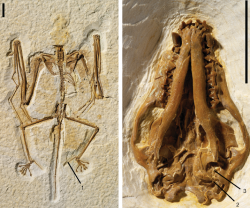Do taxonomic levels appear too suddenly?
Not only do new mammalian orders appear suddenly, but when they appear, they are already separated into their distinctive forms. For example, during the Eocene epoch (just after the Paleocene), the first fossil bat appears suddenly in the fossil record. When it does, it is unquestionably a bat, capable of true flight. Yet, we find nothing resembling a bat in the earlier rocks.Explore Evolution, p. 24
Flowering plants appear suddenly in the early Cretaceous period, 145-125 million years ago.Explore Evolution, p. 24
 A bat: from Wikicommons
A bat: from Wikicommons
Summary of problems with claim: Even if true, this claim does not undermine evolution. This is simply the way evolution proceeds.
Full discussion: Explore Evolution wants to make it seem as if the sudden appearance of new, well-formed organisms is problematic. In fact, this is exactly what punctuated equilibrium predicts.
 Onychonycteris finneyi: a transitional bat described by Simmons et al. (2008). Modified image used with permission. Scale bar = 1 cm. Explore Evolution is inaccurate, however, in its claim that there are no transitional bat fossils. Simmons et al. (2008) describe a transitional bat, Onychonycteris finneyi, from the Eocene of Wyoming (52.5 Ma) that has clawed digits and lacks ears suitable for echolocation. O. finneyi has short wings and long legs.
Onychonycteris finneyi: a transitional bat described by Simmons et al. (2008). Modified image used with permission. Scale bar = 1 cm. Explore Evolution is inaccurate, however, in its claim that there are no transitional bat fossils. Simmons et al. (2008) describe a transitional bat, Onychonycteris finneyi, from the Eocene of Wyoming (52.5 Ma) that has clawed digits and lacks ears suitable for echolocation. O. finneyi has short wings and long legs.
The existence of O. finneyi shows two things: 1) bats evolved with intermediate, transitional forms, and 2) continued creationist usage of bats to bolster their claims of "sudden appearances" reflects more on creationist unfamiliarity with the subject material than the actual fossil record.
Flowering plants are called angiosperms. The oldest angiosperm fossil--an aquatic plant named Archaefructus liaoningensis--dates not from 145 Ma, but from 125 Ma. This discovery was described in 2002.
Explore Evolution, quoting a 2005 paper in Trends in Ecology and Evolution, goes on to say:
Angiosperms appear rather suddenly in the fossil record " This contradiction was so perplexing that Darwin himself referred to it as "an abominable mystery.Explore Evolution, p. 24
The sudden appearance of a new group in the fossil does not constitute a "contradiction." Rather, this is simply the way in which many organisms--either by rapid evolution or a sparse fossil record--show up in the fossil record.
Simmons, N.B., Seymour, K.L., Habersetzr, J., and Gunnell, G.F., 2008. "Primitive Early Eocene bat from Wyoming and the evolution of flight and echolocation." Nature 451, 818-821 (14 February 2008).
